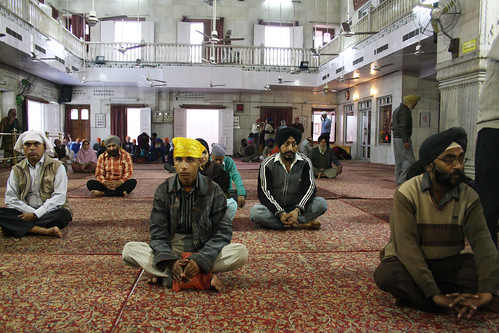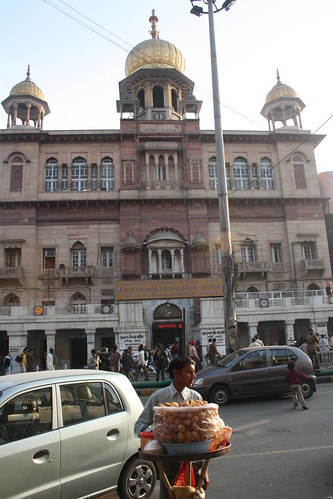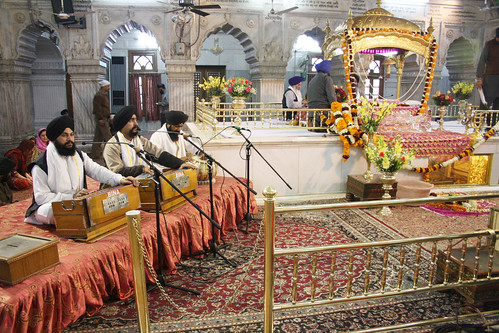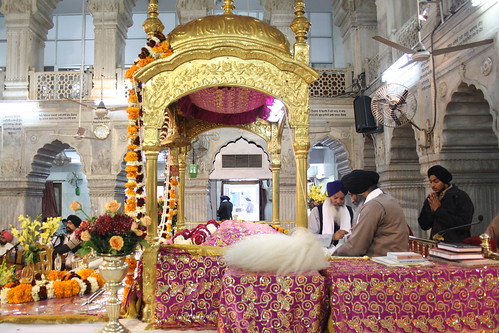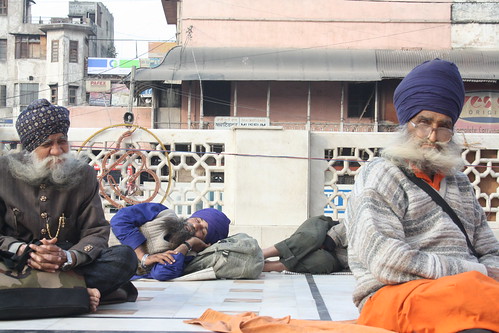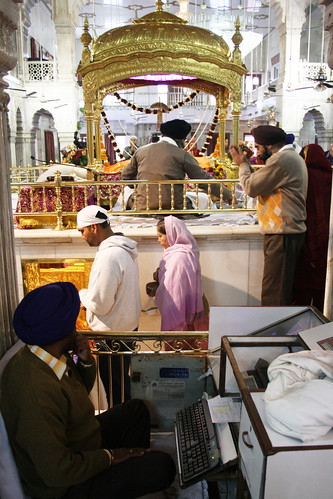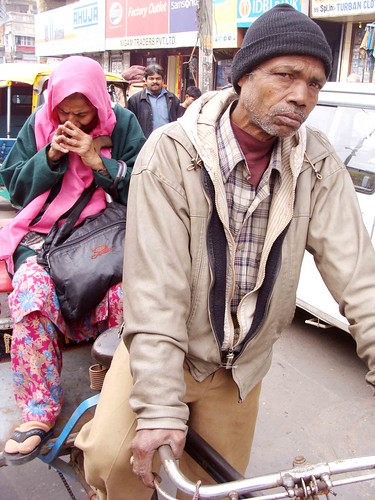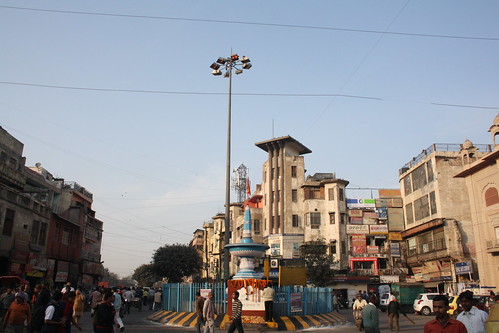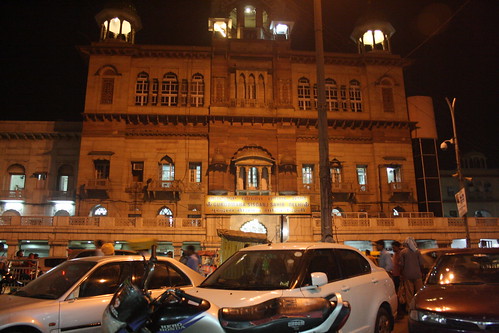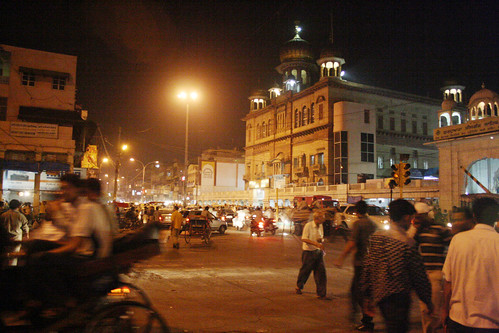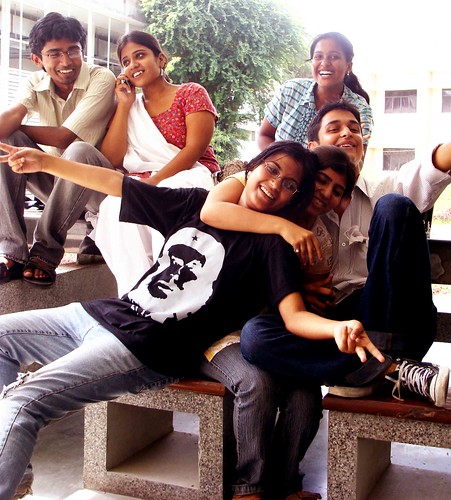The Delhi Walla is my Arundhati Roy - Surbhi Jain, a book-lover from Faridabad, near DelhiContact mayankaustensoofi@gmail.com for ad enquiries.![]() Campus Notepad - Reading Chomsky in Gulistan-e-Gandhi
Campus Notepad - Reading Chomsky in Gulistan-e-GandhiJamia Millia University is home to eclectic figures; by Mayank Austen Soofi
City Food - Fenn, Matia MahalDelhi's most democratic bread; by Mayank Austen Soofi
City Landmark - Gurdwara Seesganj, Chandni ChowkHoly and serene; by Mayank Austen Soofi
Mission Delhi – Salim Javeri, Nizamuddin BastiOne of the one per cent in 13 million; by Mayank Austen Soofi
Capital Notice – An American Reader Partially Funds The Delhi WallaPeter Saal gifts a Flickr subscription; by Mayank Austen Soofi
City Food – Ram Laddoo, Around TownSimple and honest; by Mayank Austen Soofi
City Season – Amaltas Tree, Hauz Khas VillageThe summer’s gift; by Mayank Austen Soofi
Mission Delhi – Sunita Pandit, Palika Bazaar ParkOne of the one per cent in 13 million; by Mayank Austen Soofi
City Food - Samosa, Delite Cinema & Scindia LaneDelhi’s biggest and smallest samosas; by Mayank Austen Soofi
City Monument - Mughal Masjid, MehrauliDelhi’s most beautiful mosque; by Mayank Austen Soofi
City Life - Love, Friendship, SexWhat Delhiwallas want; by Mayank Austen Soofi
Mission Delhi – Kareem Khan, Nehru PlaceOne of the one per cent in 13 million; by Mayank Austen Soofi
City Food – Lassi, Chandni ChowkThe cool yoghurt drink; by Mayank Austen Soofi
City Kitchen – Julia Child in GB RoadThe great chef's life in Delhi; by Mayank Austen Soofi
City Locality – Middle Lane, Connaught PlaceNobody loves it; by Mayank Austen Soofi
Mission Delhi – Ram Swaroop Sharma, India Gate MaidanOne of the one per cent in 13 million; by Mayank Austen Soofi
City Food - Number Walli Kulfi, Old DelhiThe sweet game; by Mayank Austen Soofi
Photo Essay - Faces of DelhiYour people, my people; by Mayank Austen Soofi
City Landmark – Rajiv Gandhi Setu, Ring RoadAn urban refuge; by Mayank Austen Soofi
Mission Delhi – Surinder, Pataudi HouseOne of the one per cent in 13 million; by Mayank Austen Soofi
City Environment – Yamuna River, Jamuna BazaarDelhi's holy maa; by Mayank Austen Soofi
City Landmark – Tughlakabad Fort, Near BadarpurThe solitary savageness; by Mayank Austen Soofi
City Neighbourhood – Kashmere Gate, North DelhiIn search of lost time; by Mayank Austen Soofi
City Interview – Fatima Bhutto, Pakistani AuthorThe new Daughter of the East; by Mayank Austen Soofi
City Festival - Urs, Hazrat Nizamuddin DargahCelebrating the saint's death; by Mayank Austen Soofi
Mission Delhi - Muhammad Waseem, Near BarakhambaOne of the one per cent in 13 million; by Mayank Austen Soofi
City Landmark - Red Fort, Old DelhiThe necessary ruin; by Mayank Austen Soofi
Pakistan Diary - Travels in My CountryThe Delhi Walla in the fatherland; by Mayank Austen Soofi
Mission Delhi - Rachana Rao Umashankar, Shahpur JatOne of the one per cent in 13 million; by Mayank Austen Soofi
City Secret - Hijron ka Khanqah, MehrauliA getaway for the eunuchs; by Mayank Austen Soofi
Photo Essay – The Heartbeat of DelhiConnaught Place after 8 pm; by Mayank Austen Soofi
Mission Delhi – Aarti, GB RoadOne of the one per cent in 13 million; by Mayank Austen Soofi
City Landmark - Indira Gandhi Memorial Museum, Safdarjung RoadInside the Lutyens' bungalow; by Mayank Austen Soofi
City Season – Leaf-dropping in DelhiThe Capital’s fall; by Mayank Austen Soofi
City Notice - Jashn e Khusrau, Sufi FestivalFrom March 4th to 14th; by Mayank Austen Soofi
Mission Delhi – Sarah Rose, Cathedral Church of the RedemptionOne of the one per cent in 13 million; by Mayank Austen Soofi
City Life – The Curious Case of KalooThe darling of Jor Bagh; by Mayank Austen Soofi
City Music - The Real Sufi StarsThe qawwals of Hazrat Nizamuddin; by Mayank Austen Soofi
City Secret - Nicholson Cemetery, Kashmere GateThe other world; by Mayank Austen Soofi
Mission Delhi – Syed Haider Raza, Hauz Khas EnclaveOne of the one per cent in 13 million; by Mayank Austen Soofi
The Independent View - On Mission DelhiPraise for the project; by Andrew Buncombe
Photo Essay - Sense of the PlaceIn love with clichés; by Mayank Austen Soofi
Mission Delhi - Muhammad Aslam, Nizamuddin BastiOne of the one per cent in 13 million; by Mayank Austen Soofi
City Season – Palika Bazaar Park, Connaught PlaceShort and beautiful; by Mayank Austen Soofi
Sujan Singh Park Diary – My Life with Khushwant SinghOn Delhi’s legendary writer; by Sadia Dehlvi
City Secret - Jain Svetambar Temple, Kinari BazaarThe luxury of the ascetics; by Mayank Austen Soofi
Mission Delhi – Deen Dayal, Safdarjung EnclaveOne of the one per cent in 13 million; by Mayank Austen Soofi
City Landmark – Kamla Market, Central DelhiAsia’s big air-cooler bazaar; by Mayank Austen Soofi
Dateline Stockholm – The Delhi Walla Enters the Nobel Prize ClubThe blogger’s photography gets recognition; by Mayank Austen Soofi
Mission Delhi – Sumanta Roy, Khan MarketOne of the one per cent in 13 million; by Mayank Austen Soofi
City Landmark - Hauz Khas Ruins, South DelhiVerses in stone; by Mayank Austen Soofi
City Secret - Hardayal Municipal Public Library, DaryaganjThe newspaper readers' club; by Mayank Austen Soofi
Mission Delhi – Rakesh Chandra, Connaught PlaceOne of the one per cent in 13 million; by Mayank Austen Soofi
City Landmark - Khan-i-Khana's Tomb, Nizamuddin EastScarred with beauty; by Mayank Austen Soofi
Special Report – The Delhi Walla in JaipurNotes from the fifth Jaipur Literature Festival; by Mayank Austen Soofi
Photo Essay - Basant Celebrations, Hazrat Nizamuddin DargahColour me yellow; by Mayank Austen Soofi
Mission Delhi - Changa Kumar, Hauz Khas VillageOne of the one per cent in 13 million; by Mayank Austen Soofi
City Landmark - Birla Temple, Mandir MargThe land of Vishnu; by Mayank Austen Soofi
City Kitchen – Julia Child in JorbaghThe great chef's life in Delhi; by Mayank Austen Soofi
City Secret - Raja Bookstore, PaharganjAlmost like Paris; by Mayank Austen Soofi
Mission Delhi - Aanchal Malhotra, Jama MasjidOne of the one per cent in 13 million; by Mayank Austen Soofi
City Secret - Razia Sultana's Tomb, Pahari BhojlaIndia's first woman ruler is sleeping here; by Mayank Austen Soofi
City Commute – Business Class for Delhi Metro?The mass in the mass rapid transit system; by Mayank Austen Soofi
Mission Delhi – Pooja, PaharganjOne of the one per cent in 13 million; by Mayank Austen Soofi
City Secret - Begumpuri Masjid, Sarvapriya ViharSimple and grand; by Mayank Austen Soofi
City Neighbourhood - Pratap Street, DaryaganjThe alley’s private life; by Mayank Austen Soofi
Photo Essay 2010 – In Search of Lost TimeOn the New Year's eve; by Mayank Austen Soofi
Mission Delhi – Mushirul Hasan, JNU CampusOne of the one per cent in 13 million; by Mayank Austen Soofi
Photo Essay – Season’s Greetings, Bhikaji Cama PlaceLest we forget; by Mayank Austen Soofi
City Cinemas - SRS, JAM, BIG, MMX, G3SThe PVRisation of film halls; by Mayank Austen Soofi
City Faith - Muharram & ChristmasMourning and celebrating; by Mayank Austen Soofi
Mission Delhi - Satnam Singh Juneja, Pratap StreetOne of the one per cent in 13 million; by Mayank Austen Soofi
City Secret - Agrasen ki Baoli, Connaught PlaceThe well of solitude; by Mayank Austen Soofi
City Faith – Ramayan Paath, SahibabadFinding peace in the Hindu epic; by Mayank Austen Soofi
Mission Delhi – Shankar, Matia MahalOne of the one per cent in 13 million; by Mayank Austen Soofi
City Living - Too Many DelhisIt's too varied; by Mayank Austen Soofi
Photo Essay - Traffic Jam, Kasturba Gandhi MargThe carefree hours; by Mayank Austen Soofi
Mission Delhi - Berenice Ellena, JangpuraOne of the one per cent in 13 million; by Mayank Austen Soofi
Madrid Confessions - What I Really DidSchmap Madrid Guide has liked The Delhi Walla; by Mayank Austen Soofi
Dateline GB Road – Sex Workers Want LicenseDelhi’s red light district is hopeful; by Mayank Austen Soofi
City Secret – Gole Park, Windsor PlaceAn urban Shanghri-la; by Mayank Austen Soofi
Mission Delhi – Muhammad Salim, Mathura RoadOne of the one per cent in 13 million; by Mayank Austen Soofi
Mission Delhi – One Per Cent in 13 MillionCracking the city; by Mayank Austen Soofi
City Landmark - Chanakya Cinema, Central DelhiThe landmark has vanished; by Mayank Austen Soofi
City Sighting - Arundhati Roy, Jamia Millia IslamiaShe was mobbed by admirers; by Mayank Austen Soofi
City Landmark - Mirza Ghalib's Tomb, Nizamuddin BastiRestoring the dignity of Delhi's greatest poet; by Mayank Austen Soofi
Photo Essay - Celebrating Arundhati RoyOn the Delhi-based author's 48th birthday; by Mayank Austen Soofi
Capital Plunder – Jantar Mantar, 19/11Delhi’s historic solar observatory attacked; by Mayank Austen Soofi
City Secret - Delhi Kishanganj Railway StationAn urban haven; by Mayank Austen Soofi
Capital Experience – Dawn @ Hazrat Nizamuddin DargahA must-see sight before you die; by Mayank Austen Soofi
City Life - Are you an Upper Class Delhi Walla?We all have dreams; by Mayank Austen Soofi
City Life – Abdul Rehman, Old Delhi RomeoLove in the Walled City; by Mayank Austen Soofi
Photo Essay - Women Are Not Allowed Inside Nizamuddin DargahThey say it's the tradition; by Mayank Austen Soofi
Capital Sighting – Khushwant Singh, Hotel Le MeridianDelhi's dirty old man; by Mayank Austen Soofi
City Secret – Hindon Railway Bridge, GhaziabadA must-see for trainspotters; by Mayank Austen Soofi
City Living – Hauz Khas Village, South DelhiA new morning at a new address; by Mayank Austen Soofi
City Sighting - Ved Mehta, Meharchand MarketThe American memoirist was seen with wife; by Mayank Austen Soofi
City Feature – Foreign Babe in ShahjahanabadOn her own in Old Delhi; by Mayank Austen Soofi
City Secret – Aleksandr Pushkin, Mandi HouseThe Russian abroad; by Mayank Austen Soofi
City Landmark – Fatehpuri Masjid, Walled CityIts simplicity is magical; by Mayank Austen Soofi
City History - Sunday Book Bazaar, DaryaganjThe origins of the market; by Mayank Austen Soofi
Photo Essay – Chhat Pooja, India GateDelhi’s several colours; by Mayank Austen Soofi
Special Feature – Why is Old Delhi So Dirty?The existential question; by Mayank Austen Soofi
Photo Essay – Will in the WorldChasing Delhi’s most popular historian; by Mayank Austen Soofi
City Neighbourhood - GB Road, Delhi-6The Capital's red light district; by Mayank Austen Soofi
Nature Notepad – Searching for the Delhi OctoberWinters must be coming; by Mayank Austen Soofi
Special Feature – William Dalrymple, The White MughalDelhi’s most famous expat author; by Mayank Austen Soofi
City Resident – Santosh Puri, Central News AgencyHer kingdom, her stories; by Mayank Austen Soofi
Capital Commandments – For a World Class DelhiA Singaporean’s hard talk with Delhiwallas; by Phebe Bay
Obituary - Connaught Place, Central DelhiThe British-built district's distinctness has disappeared; by Mayank Austen Soofi
City Resident - Editor, Nizamuddin EastIndia's most written about dog; by Mayank Austen Soofi
City Life – Vijay Chauhan, The DishwasherTracing Mahatma Gandhi’s complex legacy; by Mayank Austen Soofi
Capital Guide - The Eighth City of DelhiThe Sufi underworld; by Mayank Austen Soofi
Madrid Diary – The Last WordLooking at Delhi with new eyes; by Mayank Austen Soofi
Madrid Diary – The Farewell SymphonyThe last day in the Spanish Capital; by Mayank Austen Soofi
Madrid Diary – The Iberian SkyPoetry in the heavens; by Mayank Austen Soofi
Madrid Diary – The Beautiful PeoplePortraits from Spain; by Mayank Austen Soofi
Madrid Diary – Metro MelodiesTime out in the Alonso Martinez stop; by Mayank Austen Soofi
Madrid Diary – Their Monuments, Our MonumentsTime out in San Lorenzo De El Escorial; by Mayank Austen Soofi
Madrid Diary - Second Day, Second ShowTime out in the Spanish Capital; by Mayank Austen Soofi
Madrid Diary - First Day, First ShowTime out in the Spanish Capital; by Mayank Austen Soofi
City Landmark – Hotel Taj Mahal, Church Mission RoadA well-kept secret; by Mayank Austen Soofi
Letter from the Reader – On Publishing Slanderous CommentsThe dilemma of free speech on the internet; by Jess Sikand
City Life – Delhi’s Beautiful PeopleLoving the 'filthy' Yamuna; by Mayank Austen Soofi
Photo Essay – Connaught Place in Mid-Life MakeoverCapturing the re-rise of a Delhi landmark; by Mayank Austen Soofi
Personal Life – Fast, Pray, LoveGoing foodless in Ramzan; by Sadia Dehlvi
Campus Life - The iGen, Delhi UniversityThe new blood; by Mayank Austen Soofi
City Landmark – Bagh-e-Bedil, Opposite Pragiti MaidanIn the dead poet’s society; by Mayank Austen Soofi
City Neighbourhood – BP Road, near Ajmeri GateThe XXX fantasies; by Mayank Austen Soofi
City Neighbourhood – Karol Bagh, West-Central DelhiIt has energy, warmth and sinful street food; by Mayank Austen Soofi
Photo Essay - Delhi@NightIt's dangerous, but beautiful; by Mayank Austen Soofi
City Life – A Love StoryA thumri singer on the love of her life; by Vidya Rao
City Life – The Joys of ChildhoodTwo in 13 million; by Mayank Austen Soofi
Capital News - Jane Austen is Coming to South DelhiBollywood is adapting
Emma in this city; by Mayank Austen Soofi
City Secret – Husseini Hotel, Nizamuddin BastiA poor man’s eatery, since the '40s; by Mayank Austen Soofi
City Plus – The Second-hand Bookstores of PaharganjFinding thrill in unexpected places; by Mayank Austen Soofi
City Walk - Chandni Chowk, Old DelhiA trip into the heart of the Walled City; by Mayank Austen Soofi
City Secret – DDA Park, Opposite Purana QilaA mystery best left unsolved; by Mayank Austen Soofi
Capital Guests - Three Pakistanis in a Gurgaon MallA slice of their Delhi afternoon; by Mayank Austen Soofi
Photo Essay – Is Delhi Rude?Exposing the truth; by Mayank Austen Soofi
Capital Interview - Ali Sethi, Pakistani NovelistOn writing and related concerns; by Mayank Austen Soofi
City Travel – Encounter at the Black MosqueThe passage to Nizamuddin Basti; by Marina Bang
Viewpoint – Why Scorn Delhi’s Expat Community?A South Delhi expat makes a point; by Anonymous
Photo Essay – The Cost of LivingPoor people and the price of water; by Mayank Austen Soofi
Citizen Profile - Mr Jones, Greater Kailash-IHe needs a mate; by Vasantha Angamuthu
City Landmark – NYC Unisex Salon, Hauz Khas MarketDelhi’s first LGBT friendly salon; by Mayank Austen Soofi
Delhi Diary – The Power of FaithBeauty as seen in a sufi shrine; by Mayank Austen Soofi
City Secret – Kuldeep Booksellers, DaryaganjA must-visit for book lovers; by Mayank Austen Soofi
Capital News – The Delhi Walla Gets Jane Austen-isedAn honour too good to be true; by Mayank Austen Soofi
City Season - The Rain, 23/7One afternoon in Delhi; by Mayank Austen Soofi
City Education – Delhi’s Little Red BookQuotations from
The Delhi Walla; by Mayank Austen Soofi
Photo Essay – Once Delhi, Now DelhiThe city down the decades; by Mayank Austen Soofi
City Personals – Matchmaking in DelhiThey all are well-known people; by Mayank Austen Soofi
Travel Notepad - Udaipur, "The World's Best City for Travellers" Weekend getaway in Rajasthan; by Mayank Austen Soofi
City Landmark – Khan Market Metro Stop The Metro would change Delhi's face after a few more years - and accidents; by Mayank Austen Soofi
The Delhi Walla Interview – Ms Rakhshanda Jalil on her New Avatar She has become a fiction writer; by Mayank Austen Soofi
City Life – Auto-cracy in Delhi The ride of your life; by Mayank Austen Soofi
City Virus – The Delhi Walla Gets Chicken PoxTaking things in stride; by Mayank Austen Soofi
City Escape – Khwaja Baqi Billah’s Dargah, Sadar Bazaar AreaThe silence of the tombs; by Mayank Austen Soofi
City Resident – Ms Noor Bano, The HomelessOne in 13 million; by Mayank Austen Soofi
Capital Interview – Mr Seth’s Suitable GirlThe author of
A Suitable Boy talks to
The Delhi WallaCity Getaways – Delhi in the Time of MonsoonWhere to enjoy the rains; by Mayank Austen Soofi
City Reporting – Delhi High Court Legalizes Gay SexFirst comments, first reactions; by Mayank Austen Soofi
First Thought - Freedom at MidmorningDelhi High Court has legalized homosexuality; by Mayank Austen Soofi
City Landmark – Terminal 1D, Indira Gandhi International AirportIt's better than Bombay's; by Mayank Austen Soofi
Capital Event – Delhi’s 2nd Gay Pride ParadeIt was bigger than the first; by Mayank Austen Soofi
City Report – Municipal Council of Delhi Vs Daryaganj’s book bazaarThe uncertain future of the Sunday market; by Mayank Austen Soofi
Travel Notepad – The Scooter Women of UdaipurWeekend getaway in Rajasthan; by Mayank Austen Soofi
Travel Notepad – The Strange Encounter with a Rajput PrinceWeekend getaway in Udaipur, Rajasthan; by Mayank Austen Soofi
Maximum City – Do You Like Delhi?The Capital is everyone’s favorite punching bag; by Mayank Austen Soofi
Capital Literature – Twilight in Delhi, Ahmed AliThe definitive Old Delhi novel; by Mayank Austen Soofi
City Planner - Six Day Tweeting in DelhiWhat are you doing this week; by Mayank Austen Soofi
City Landmark – The Full Circle Bookshop & Café Turtle, Khan MarketMoved from the front lane to the middle lane; by Mayank Austen Soofi
City Life – The Sufi EunuchsThe beautiful sex; by Mayank Austen Soofi
City Secret – Gandhi-King Plaza, India International CenterThe Macondo of the mind; by Mayank Austen Soofi
Campus Life - Dream Dating in Delhi UniversityDifferent types, different needs; by Mayank Austen Soofi
Campus Life – Delhi University DreamsWhat it takes to get into it; by Antara Raghavan
City Life – The Two Wives of Mr KumarFamily picnic in Lodhi Garden; by Mayank Austen Soofi
City Institution – Indian Coffee House, Baba Kharak Singh MargIt may or may not shut down; by Mayank Austen Soofi
Capital Asset – Arundhati Roy SightingIn Nizamuddin Basti; by Mayank Austen Soofi
City Secret – Bollywood Seller, BallimaranSelling Shah Rukh in Ghalib’s territory; by Mayank Austen Soofi
Photo Essay - Big City Loneliness1 in 13 million; by Mayank Austen Soofi
City Classifieds – Book Search for ShakespeareA special copy needed; by Mayank Austen Soofi
City Guest – Lychees in DelhiThey stay here for two months; by Mayank Austen Soofi
City Reporting – The Connaught Place FaceliftBotox shot for Delhi's heart; by Mayank Austen Soofi
Capital Guest – Mr Bond in DelhiA beloved author’s links to this city; by Mayank Austen Soofi
Photo Essay - Amaltas Trees, Hailey RoadThe best part of Delhi summers; by Mayank Austen Soofi
Capital Note – The Delhi Walla Gets a SponsorA reader has paid for this blogsite's flickr account
City Wonder – The Kite Flier of Nizamuddin BastiThe office peon's magic hour; by Mayank Austen Soofi
City Scene – Book Launch PartiesThey are now bigger, glitzier, informal; by Mayank Austen Soofi
Books of The Times - 'Ruined by Reading', by Mayank Austen SoofiThe definitive Delhi novel; review by Michiko Kakutani
City Hangout – Zaki Cybercafé, Nizamuddin BastiDiscovering globalization, halal style; by Mayank Austen Soofi
Viewpoint – What About The Delhi Walla?The future of
The Delhi Walla, and 'The Delhi Walla'; by Anonymous
Capital Season - Delhi in the Time of SummerFinding comfort in a steaming sun-drenched city; by Anuja Chauhan
City Guide – Hauz Khas, Near Green ParkRomancing in the ruins; by Mayank Austen Soofi
Capital Regret - On Ms Amita Malik’s Library on the RoadMs Malik's nephew writes to
The Delhi Walla; by Sarbjit Roy
City Life – The Fruit Seller of DaryaganjLiving it honestly; by Mayank Austen Soofi
Capital Regret - A Booklover's Library on the RoadLate film critic Amita Malik's books sold to a ragpicker; by Mayank Austen Soofi
City Talk – Sadia Dehlvi, Author of Sufism, The Heart of IslamThe first copy of her first book has reached her home; by Mayank Austen Soofi
City Guide – Time Out TibetExperiencing Lhasa in Delhi; by Mayank Austen Soofi
Capital Asset – Arundhati Roy SightingAt The Book Shop, Jorbagh Market; by Mayank Austen Soofi
Maximum City – The Curious Case of Mr Dorji HayerBeing Indian in the Indian Capital; by Mayank Austen Soofi
Maximum City – A Young Kashmiri in TownBeing Indian in the Indian Capital; by Mayank Austen Soofi
Capital Life – Making Love in AutosCouples say it's safer; by Mayank Austen Soofi
City Landmark – Khushwant Singh, Sujan Singh ParkDelhi’s celebrated author in his winter years; by Mayank Austen Soofi
Capital Bitching – The Delhi Walla is a Slimy GuyOverheard in a bullet train in Korea; by Namya Sinha
Capital Walk – Raisina Hill, Lutyens' DelhiAn empire of stones; by Mayank Austen Soofi
Capital Manners – Shoe Throwing Gets an OKDelhi becoming less courteous; by Mayank Austen Soofi
Mumbai Diary – Why Delhi is Better than BombayThe great city has grown less great; by Mayank Austen Soofi
Capital Heritage - Baoli, Nizamuddin BastiA 700-year-old monument gets its first full makeover; by Mayank Austen Soofi
City Landmark - Timeless Art Book Studio, Kotla MubarakpurDelhi's best coffee-table bookshop gets a second life; by Mayank Austen Soofi
Obituary – Qasim Ali, A Good ManHe died on March 29th, aged 25; by Mayank Austen Soofi
Table for One - Everest Café, PaharganjFood lovers' guide to Delhi; by Mayank Austen Soofi
The New Dalit - Praveen Parcha, Valmiki SadanHe is against job reservations for Dalits; by Mayank Austen Soofi
Opinion – Polka Club's Pink ParadoxDelhi's sole Saturday night gay disco is horrid; by Anonymous
Real Estate Classified – Flat Wanted in Nizamuddin or JangpuraAir conditioners a must to survive Delhi summer; by Satya Prateek
City Pleasure – Street Cricket, India GateDelhi loves its cricket; by Mayank Austen Soofi
City Life - Citywalk Mall, SaketMalling in the time of slump; by Mayank Austen Soofi
City Life – Gay Saturdays at Polka Club, Kailash ColonyChasing the pink rupee; by Mayank Austen Soofi
Ahmedabad Diary – The Idea of the Hindu StateThe city’s Hindu youth have forgotten the anti-Muslim progroms; by Mayank Austen Soofi
Travel Notepad – Not so DelhiSix un-Dilli experiences; by Mayank Austen Soofi
Gujarat Notepad – The Enigma of Mr ModiUnderstanding the charisma of India’s most divisive politician; by Mayank Austen Soofi
Capital Artist – Keywan, Landscape PainterAn afternoon with a Sainik Farms-based artist; by Mayank Austen Soofi
Travel Diary – Narmada River, Surat-Ahmedabad HighwayA fisher boy with river secrets; by Mayank Austen Soofi
Surat Notepad – Asmita Makwana, the Bandit QueenKudi Gujarat ki; by Mayank Austen Soofi
Travel Notepad – Surat, GujaratJai Ho to the Surati rickshaws; by Mayank Austen Soofi
Travel Notepad – Surat, GujaratA beautiful but divided city; by Mayank Austen Soofi
City Guide - Main Bazaar, PaharganjDelhi's smoggiest zone is worth a visit; by Mayank Austen Soofi
Viewpoint - Delhi is a BitchHow the city lost its virginity; by Anonymous
The New Dalit - Neeta Vaid, Valmiki SadanShe wants other people to bow before her; by Mayank Austen Soofi
Photo Essay – Rajiv Gandhi Jhuggi Camp, East DelhiSlum guide for dummies; by Mayank Austen Soofi
Maximum City – Being Indian in the Indian CapitalA young man from Kashmir says that India is not his country; by Mayank Austen Soofi
Dateline Delhi – Slipper Thrown At Arundhadti Roy, Auctioned Off at Jantar MantarSign of the times; from a newspaper clipping
The New Dalit – Sanjay Salwan, Valmiki SadanHe wants to be the world's best saxophone player; by Mayank Austen Soofi
Feature – My Dad's Bookshop, My Dad's CustomersAn insider's gossip on Delhi's most eclectic bookstore; by Jairaj Singh
Valentine's Day 2009 – The Lover Boy of Nizamuddin BastiThis butcher has a lamb's heart; by Mayank Austen Soofi
Around Town – Kareena Kapoor SightingThe Bombay star was in Connaught Place; by Mayank Austen Soofi
Photo Essay – Purani Dilli on a HighAllah is closer to Old Delhi rooftops; by Mayank Austen Soofi
Special Series - The New DalitThe changing world of Delhi's 'untouchables'; by Mayank Austen Soofi
Capital Guest - Daniyal Mueenuddin, Pakistani AuthorHanging out in Lodhi Garden; by Mayank Austen Soofi
City Hero – Vicky Roy, Ragpicker turned LensmanDelhi's own 'slumdog millionaire'; by Mayank Austen Soofi
Photo Essay – St Stephen’s College, North CampusIts snob value is worth it; by Mayank Austen Soofi
Citizen Profile – Naz Ikramullah, ArtistA Pakistani-Canadian who is a Delhiwalli, too; by Mayank Austen Soofi
City Secret - Blood Letting in Old DelhiHere illnesses are cured by slashing the body with blades; by Mayank Austen Soofi
City Watch – The Twin Worlds of GB RoadThe many faces of Delhi's red light district; by Mayank Austen Soofi
Photo Essay – Sky Spotting, Around TownIn love with the deceitful season; by Mayank Austen Soofi
Barack Special – What's Obama to Me?Asking for Obama in Delhi's Dalit Colony; by Mayank Austen Soofi
Barack Special - Obama Puri to Obama ViharWhat if Barack Obama was a Delhi neighbourhood; by Mayank Austen Soofi
Photo Essay – We are the Beauty QueensThey’re lovable and beautiful; by Mayank Austen Soofi
City Institution - Sunday Book Bazaar, DaryaganjYour guide to Delhi's biggest book market; by Mayank Austen Soofi
City Nightmare - "Girls are coming, let's tease them"Private horror zones in India’s rape capital; by Mayank Austen Soofi
City Life – Ta Ta Thayya in a Thuk ThukDial a Delhi auto for Bollywood item numbers; by Mayank Austen Soofi
Viewpoint - Understanding Delhi and The Delhi WallaA PhD scholar at Stanford gives his take on this blogsite; by Gaurav Sood
Photo Essay – Enter from the BacksideDelhi’s English is a very funny language; by Mayank Austen Soofi
City Season – The Midnight Summer's DreamIt’s not winter but summer that makes Delhi bloom; by Mayank Austen Soofi
Letter from Lahore - Delhi Belongs to Pakistanis, TooA case for complex identities sans politics; by Raza Rumi
Delhi Diary – January 1, 2009Starting the New Year with a Delhi cliché; by Mayank Austen Soofi
Delhi Diary - December 31, 2008Let's meet next year; by Mayank Austen Soofi
Book Review - Curfewed Night; Basharat PeerA former Delhi-based journo writes his first book on homeland Kashmir; by Sumaira Samad
City Society – Maids in Gay HouseholdsHow do they cope; by Mayank Austen Soofi
City Community - The Wandering Christmas ChoirOn the footsteps of an unsual band of carol singers; by Mayank Austen Soofi
City Community - Christmas Eve, 2008Translating X-mas to
Bada Din; by Mayank Austen Soofi
City Business - Bahrisons is ExpandingA south Delhi landmark is coming to west Delhi; by Mayank Austen Soofi
City Living - Where is Your Second Home?Seeking private spaces in public places; by Mayank Austen Soofi
Photo Essay – Khan Market After DarkWhen life fizzles out of Delhi’s most uppity joint; by Mayank Austen Soofi
City Landmark – Safdarjung’s Tomb, Near AIIMSThe poor man’s Humayun Tomb; by Mayank Austen Soofi
Apology – To Ms Anoushka Shankar, the Sitar PlayerA case of mistaken identities; by Mayank Austen Soofi
City Exploration - Park End Colony, KarkardoomaExodus from the Walled City; by Mayank Austen Soofi
City Landmark – Fact & Fiction, Basant LokInside Delhi’s wildly eclectic bookstore; by Mayank Austen Soofi
Travel - TIPS TO TOES IN SERVICE OF NATIONA Delhi writer follows Sign Language lessons on the Border Roads; by Mayank Austen Soofi
Bombay 26/11 Editorial - Rich India's Gravest HourWhy should no-star India cry for 5-star India; by Mayank Austen Soofi
Bombay 26/11 – Life in the Time of TerrorismBombay attacks have changed Delhi; by Mayank Austen Soofi
City Secret - Chabad House, PaharganjA home for travelling Jews; by Mayank Austen Soofi
Bombay 26/11 - Pakistan for MumbaiNot all Pakistani hands are stained with the Indian blood; by Mayank Austen Soofi
Bombay 26/11 – Delhi is FarThe show goes on in the Capital; by Mayank Austen Soofi
Dateline Bombay – Oh Taj, 26/11All Delhi wallas are Mumbaikars today; by Mayank Austen Soofi
Capital View – The Best of DelhiWhat do ex-Delhi wallas miss about the city; by Mayank Austen Soofi
City Classic - Sablok Clinic, DaryaganjThe legendary sex clinic promises a 'cure' for homosexuality; by Mayank Austen Soofi
Capital Season – Winter in DelhiDelhi ceases to be Delhi; by Mayank Austen Soofi
Maximum City -- Being Indian in the Indian CapitalA lady from Northeast India is called 'chinky noodle' in Delhi; by Mayank Austen Soofi
City Life – Spit Please, This is DelhiThe capital has a rich spitting culture; by Mayank Austen Soofi
City Walk - ITO CrossingOne morning at Delhi's most irksome traffic intersection; by Mayank Austen Soofi
Capital Neighbourhood -- A Booklover's Life in BallimaranAll he want is some quiet; by Mayank Austen Soofi
Capital Community -- How Delhi Treat its BiharisThere's a kind of soft aggression against the community; by Mayank Austen Soofi
Capital Society - Darker than ObamaWhat does Barack's victory means to dark-skinned Delhi wallas; by Mayank Austen Soofi
Dateline Obama - American Center, KG MargRecording the dawn of Obama age; by Mayank Austen Soofi
Obama Special - Obama's Delhi BoysHow Delhi's Democrats helped Obama become the US Prez; by Carolyn Sauvage-Mar
City Wildlife - Roar of the White TigerA week in the life of the beast; by Mayank Austen Soofi
City Landmark - The Book Shop, Jorbagh & Khan MarketThe past, present and future of Delhi's lovable bookstore; by Mayank Austen Soofi
Muslim Talk - "Ammi was Shocked to See Half-Naked Girls in Barista"Chatting with two ladies in Jamia Nagar; by Mayank Austen Soofi
Guest Column – The Delhi Walla is FakeThis blog presents an incomplete Delhi and stereotype the Muslims; by Sushant
Recommendation – Time Out Nizamuddin BastiThe soul of Delhi; by Mayank Austen Soofi
City Life - India Habitat Center as a Dating ZoneThe hangout for art-loving romantic couples; by Mayank Austen Soofi
Dateline Mehrauli - No Fervour for Phool Waalon ki SairA terrorist attack has disturbed the fragility of our multi-religious society; by Mayank Austen Soofi
City Watch - Is New Friends Colony Friendlier?The strange logic behind the naming of Delhi locales; by Mayank Austen Soofi
Book Review – The Immigrant, Manju Kapur Delhi’s middle-class chronicler enters a new territory and fails; by Mayank Austen Soofi
City Walk – Gali Qasim Jaan, BallimaranStrolling in Mirza Ghalib’s street; by Mayank Austen Soofi
Capital Life - Self in the CityDiscovering one’s own presence in Delhi; by Mayank Austen Soofi
Photo Essay - Bihar Diary VI, Dignity at All CostLosing everything but not grace; by Mayank Austen Soofi
City Walk – Hailey Road, Near Connaught PlaceA must visit for solitary seekers; by Mayank Austen Soofi
Citizen Profile - Kareem, The Bookseller of Nehru PlaceDelhi's elusive street artist; by Mayank Austen Soofi
Capital Debut - Solar Rickshaws, Chandni ChowkNew commute in the city; by Mayank Austen Soofi
Capital Times - Uneasy Lies the HeadDonning a Muslim skullcap; by Mayank Austen Soofi
Photo Essay – Eid Mubarak, Old DelhiAll happy families are alike; by Mayank Austen Soofi
Capital Decline - Bookless in DelhiThe city's bookworld may be dying; by Mayank Austen Soofi
Letter from Jamia Millia - One Night in the Boys' HostelA peek into the mind of young Muslims; by Mayank Austen Soofi
City Landmark - Delhi Photo Company, JanpathA photography studio that has survived the modern times; by Mayank Austen Soofi
City Commute - Lady in Red, AC BusesThe Delhi Walla takes a ride; by Mayank Austen Soofi
Bihar Diary-V: In the Heart of DarknessSorrows of a far-flung correspondent; by Mayank Austen Soofi
Jamia Nagar - Delhi's Rich Muslim GhettoThe Muslim boom town in the capital; by Mayank Austen Soofi
Capital Nonsense - A Chick lit for Delhi GirlsOffering a book proposal; by Mayank Austen Soofi
9/13 Opinion - Scavengers in the Blast SitesTo be or not to be a reporter; by Mayank Austen Soofi
Bihar Diary-IV: Love and LossDon't forget Bihar's personal tragedies; by Mayank Austen Soofi
9/13 – Memoirs of the Day AfterMaking sense in the aftermath; by Priya Sen
9/13 Photo Essay – Delhi in GriefLet the Capital cry; by Mayank Austen Soofi
9/13 – Serial Bomb Blasts Rock DelhiO Delhi, my Delhi; by Mayank Austen Soofi
Bihar Diary-III: Papa, I Don’t Wanna Go HomeThe Delhi Walla in the flood hit Bihar; by Mayank Austen Soofi
Bihar Diary-II: Misery in the Water WorldThe Delhi Walla volunteers in the flood hit Bihar; by Mayank Austen Soofi
Bihar Diary-I: First ImpressionsThe Delhi Walla goes to volunteer in the flood hit region; by Mayank Austen Soofi
City Guide – Thank God It’s RamzanFestive guide to Muslim Delhi; by Mayank Austen Soofi
City Buzz - Castro Café, Jamia MiliaYoung life in the university canteen; by Mayank Austen Soofi
City Secret - Sanjay Akhara, Majnu ka TilaA special camp for wrestlers; by Mayank Austen Soofi
Pretentious Gourmand - Diva, GK-IIGluttony at Delhi's priciest stand-alone restaurant; by Mayank Austen Soofi
Society - Run Lutyens RunSearching for a perfect Lutyens’ living room; by Mayank Austen Soofi
Rant - Leave Delhi's Gay Bars AloneA response to
The Delhi Walla's article on Peg N Pints; by Priya Sen
Special - A House for Mr MusharrafPakistan's former Prez should return to his hometown Delhi; by Mayank Austen Soofi
Capital Institution - Memories of StephaniaOn St Stephen's, Delhi's most prestigious college; by Shashi Tharoor
Society - Delhi's Low Parsi 'Meter'The city's Parsis are struggling to survive; by Mayank Austen Soofi
Photo Essay - Shab-e-Baraat at Hazrat NizamuddinObserving the holy night in the Dargah; by Mayank Austen Soofi
Society - Rich Girls, Handsome MilkmenA south Delhi girls runs off with a
doodhwaala; by Mayank Austen Soofi
Capital Memory - Yesterday Tehran, Today DelhiCoping with the whims of an evolving city; by Shahnaz Husain
Citizen Profile - Rohit Malik, Delhi's Struggling BloggerConfronting, fighting and surviving odds; by Mayank Austen Soofi
City Life - Defence Colony DreamsLiving a Happy India life in South Delhi; by Mayank Austen Soofi
City Buzz - Barack's Backroom Boys in DelhiYanks play their politics in the Indian capital; by Mayank Austen Soofi
Exclusive - Pakistani Novelist Reviews The Delhi Walla's Sister SitePakistan Paindabad's intentions are good, the execution clumsy; by Bina Shah
Column - Delhi by the BookA Pakistani blogger-author is writing a travelogue on Delhi; by Raza Rumi
City Sightseeing - Heritage Tour 2008A tour of the 21st century Delhi; by Mayank Austen Soofi
City Life - Demolishing the UnwantedThis ain't no city for the poor; by Mayank Austen Soofi
In Town - Readers of Arundhati RoyPossessed by
The God of
Small Things; by Mayank Austen Soofi
City Life - Bus No. 620Sightseeing in Delhi's most scenic bus route; by Mayank Austen Soofi
City Pulse - 7pm in Khan MarketLife in Delhi's Upper East Side; by Mayank Austen Soofi
Feature - Talking Life in GB RoadWith sex workers in Delhi's red-light district; by Mayank Austen Soofi
Feature - Delhi, the City of VillagesThere are 275 of them in the metropolis; by Mayank Austen Soofi
City Notes - No Women Inside Nizamuddin DargahShame on the house of Delhi's best known Sufi shrine; by Mayank Austen Soofi
City Life - Getaways from Middle Class DelhiSave me from respectable people; by Mayank Austen Soofi
Cityscape - Will Delhi Wake Up to its Heritage?Sexing up the city's ruins; by Mayank Austen Soofi
Special - 29/6, The Day Delhi Came OutInterview with Lesley Esteves, of Delhi Queer Pride Committee; by Mayank Austen Soofi
Weekend Getaway - Nainital Behind the MistA journey into an Himalayan lake town; by Mayank Austen Soofi
Living - Gay Couple in DelhiAn American expat talks about same-sex relationships; by James Baer
Special - Crass is the CityDelhi Chief Minister calls Delhi the "most crass and show-offish city"; by Mayank Austen Soofi
City Life - No Gas Masks in Delhi MetroSmelly commute and other woes in the city metro; by Sanchita Guha
City Life - Reading Lolita in DelhiA stranger in one's own city; by Mayank Austen Soofi
Commuting - Delhi’s Dream BusWish list for an ideal city bus; by Mayank Austen Soofi
City Life - Delhi-Lahore Hip FactorYoung life in both cities is a blend of cafe culture and retail nirvana; by Raza Rumi
City LIfe - On the Banks of YamunaA dream city by the dream river; by Mayank Austen Soofi
Photo Essay - Chicks of DelhiYour guide to the city's eye candy; by Mayank Austen Soofi
Living - No Room for Love MakingYoung Delhi
wallas can't find a place for sex; by Steven Baker
Photo Essay - Bookshop Romance of DelhiThe city has a love for books; by Mayank Austen Soofi
City Life - Discount Shopping at Humayun's TombMalls, monuments, malls, monume...malls; by Mayank Austen Soofi
Viewpoint - Jane Austen in DelhiWhat if Delhi had its own Jane Austen Society; by Mayank Austen Soofi
Living - Those Delhi SummersDelhi's wretched heat has lost its zing; by Sadia Dehlvi
Obituary - The Bookworm, Connaught PlaceDelhi’s legendary bookstore is to die, aged 31; by Mayank Austen Soofi
Photo Essay – The Joys of PovertyShame and shamelessness in the walled city; by Mayank Austen Soofi
City Life - Raving 'n' Ranting in Gay DelhiFriday night in an über-fashionable club; by a discrete Delhi
wallaGuest Column - From Djinns to PandavasMy journey into the mysteries of Delhi; by Rudradeep Chakrabarti
Photo Essay – Arundhati Roy SightingsThere goes the jazz tune; by Mayank Austen Soofi
Opinion - What's Wrong with The Delhi Walla?This blogsite has lost its focus; by Shaheen Sultan Dhanji
Pssss of the Town - Bird Scare, LSD hangoverAll the news that’s not fit to print; by Mayank Austen Soofi
City Landmark – Hazrat Sarmad Shaheed, Old DelhiIn the shrine of Delhi’s naked sufi; by Mayank Austen Soofi
City Neighbourhood – Gole MarketExcursion into the British-built district; by Mayank Austen Soofi
Travel – Mapping the Muslim DelhiA city that shaped the contours of Indo-Muslim identity; by Raza Rumi
Culture – Inside Khushwant Singh’s Living RoomIn the company of Delhi’s living landmark; by Mayank Austen Soofi
City Landmark – Razia Sultan’s Tomb, Near Turkman GateA walk into the past; by Mayank Austen Soofi
“There’s No Exclusive Gay Pub in Delhi But…” – Interview with a Gay BloggerConversations with a man who runs a blog on the city’s gay life; by Mayank Austen Soofi
Around Town - Sadia Dehlvi, the Rickshaw WalliThe writer's second car is a...cycle rickshaw; by Mayank Austen Soofi
Culture - Din Duniya, a Gentle MadnessOne man's struggle to save a dying Urdu publication; by Mayank Austen Soofi
Photo Essay – The Pee Men of DelhiGive them a wall and they will pee; by Mayank Austen Soofi
Lhasa Diary - From Delhi to Tibet, and BackMy search for home; by a Tibetan refugee
City Secret - Indian Coffee Depot, Tolstoy LaneAn excellent coffee store that no-one knows; by Mayank Austen Soofi
Dateline Jamia Nagar - No Pizzas for MuslimsFast-food chains don't deliver in Delhi's Muslim ghetto; by Mayank Austen Soofi
Opinion - The Why of Hating DelhiThis city sucks big time; by a discrete Delhi
wallaProfile – R V Smith, Delhi’s Classic ChroniclerThe city has ignored its most endearing lover; by Mayank Austen Soofi
Delhi Diary – Evenings with Jahanara FakeeraStrange encounters in the tomb of a woman sufi; by Mayank Austen Soofi
Travel Guide - 36 Hours in New DelhiWeekend out in India's most happening metropolis; by Somini Sengupta
Opinion - No Rickshaws in Chandni ChowkCity planners have lost it; by Mayank Austen Soofi
Jantar Mantar Diary – Killings in Lhasa, Unrest in DelhiAmidst the city's Tibetan citizens (6 pics inside); by Mayank Austen Soofi
Living - The Garden Lovers of DelhiDiscover favrouite gardens for discrete dating; by Mayank Austen Soofi
City Landmark - Ghalib Academy, Hazrat Nizamuddin BastiDen of the dead poet's society; by Mayank Austen Soofi
Women's Day Special - Chasing the Working Women of Delhi Living a hard but independent life (9 pictures inside); by Mayank Austen Soofi
Delhi Diary – No City for a MuslimPersonal account of discrimination against Muslims; by Saif
Citizen Profile - A Coolie's ChronicleA porter's life in the Hazrat Nizamuddin railway station; by Mayank Austen Soofi
Neighbourhood - Majnu Ka Teela, The New PaharganjA new backpacker ghetto in town; by Mayank Austen Soofi
Dubai Diary – Dilli Door Ast, or Delhi is FarA Delhi girl finds a better life in the middle-eastern metropolis; by Manika Dhama
Profile - Raza Rumi, A Pakistani About TownA budding writer from Lahore visits the city of his beloved author; by Mayank Austen Soofi
"I Don't Like Delhi's Crotch-Grabbing, Foul-Mouthed Coarseness"-Exclusive Interview with Siddhartha Basu, India's No. 1 Quiz MasterThe iconic face of Indian TV finishes his conversations with
The Delhi WallaCity Secret – Afternoon Siesta, Hazrat NizamuddinA retiring refuge in this noisy city; by Mayank Austen Soofi
Dateline Delhi – Taslima Nasreen in TownArundhati Roy demands Indian citizenship for the exiled Bangladeshi author; by Mayank Austen Soofi
Opinion – Jama Masjid in DangerThe sanctity of the ancient quarter is at risk; by Sadia Dehlvi
Opinion – Kill the Jama MasjidCity planners to build an underground mall next to this historic mosque; by Mayank Austen Soofi
City Neighbourhood - Punjabi BaghYour guide to Delhi's signature district; by Mayank Austen Soofi
Delhi & Lahore – A Tale of Two CitiesExploring the brother-city Lahore; by Mayank Austen Soofi
"The Sweet Smell of Hash Filled the Nooks and Corners of St. Stephen's" - Interview with Siddhartha Basu, India's No. 1 Quiz Master (Part II)The iconic face of Indian TV muses on Delhi with
The Delhi WallaPage 3 Delhi – Pssss of the TownAll the news that’s not fit to print; by Mayank Austen Soofi
Shopping – Card Street, Chawri BazaarA street dedicated to wedding cards; by Mayank Austen Soofi
"Bombay is now my Karmabhoomi, Not Delhi" - Exclusive Interview with Siddhartha Basu, India's No. 1 Quiz Master (Part I)The iconic face of Indian TV sits down with
The Delhi WallaPhoto Essay – Muharram Mourning, Kashmiri GateThe heart could not hold its tears; by Mayank Austen Soofi
City Secret - Antique Coins, DaryaganjFrom Mughal-era to Czarist coins; by Mayank Austen Soofi
City Secret - Carrom Clubs, Muslim DelhiStumbling into a secret society; by Mayank Austen Soofi
Viewpoint – My Delhi Vs Lucknow, Punjabis and the AmericansThe city is changing its hues; by Sadia Dehlvi
Media Report - The Delhi Walla is the Most Compelling and Attractive Indian BlogMail Today newspaper, part of the India Today Group, is awestruck by this blogsite
January 1st, 2008 - Letter from The Delhi WallaComing home to Dilli; by Mayank Austen Soofi
Merry Christmas - Organ Music, Cathedral Church of RedemptionListing to pipe organ in the Sunday service; by Mayank Austen Soofi
City Landmark - Sapru House, Barakhamba RoadChronicling the decline of a great institution; by Mayank Austen Soofi
Sightseeing - On a High in Jama MasjidWatching 21st century Delhi from a 17th century minaret; by Mayank Austen Soofi
Delhi for Children - Teddy Bears in Shining IndiaBuild-a-Bear Workshop for rich people's children; by Mayank Austen Soofi
Page 3 Delhi – Pssss of the TownAll the news that's not fit to print; by Mayank Austen Soofi
City Trends - Tea Rooms in DelhiFrom New Delhi's Chai-bars to Old Delhi's Chai-khanas; by Mayank Austen Soofi
City Secret – The New Jumbo PointA new watering hole for plane watchers; by Mayank Austen Soofi
"Delhi's Muslim Culture is Dying" - Interview with Sadia DehlviThe irrepressible Delhi walli talks on her Delhi; by Mayank Austen Soofi
Culture – Anita Desai in TownThe venerable novelist visits her old city; by Mayank Austen Soofi
Weekend Getaway - Pragpur, Himachal PradeshTaking a break in the Himalayan foothills; by Mayank Austen Soofi
Eating - Winter Breakfast in Old DelhiPaya-Nihari under the shadow of Jama Masjid; by Mayank Austen Soofi
Diary - Living in Jangpura ExtensionHouse hunting in Delhi's middle-class neighbourhood; by Lesley E
Living - My Life in G. B. RoadA sex worker on living in Delhi's red light district; as told to Mayank Austen Soofi
Photo Essay – Turkish Delight in DelhiWhen Konya’s whirling dervishes came to town; by Mayank Austen Soofi
Special Report - New Stars in Delhi TheaterThe emerging heroes of Mandi House; by Mayank Austen Soofi
City Secret - The Body Re-Builder of MahipalpurThe desi way to mend broken bodies; by Mayank Austen Soofi
Diary - A Karachi Walla in DelhiCurses are same but Bhai becomes Bhaiyya; by Shandana Minhas
Table for One - Nehru Memorial Canteen, Teen Murti BhawanFood lovers’ guide to Delhi; by Mayank Austen Soofi
City Secret – Anjali Book World, Lajpat NagarHere you get classic first editions for cheap; by Mayank Austen Soofi
Delhi for Children – National Rail MuseumA special Delhi guide for readers with children; by Mayank Austen Soofi
Delhi Diary - Star Gazing in Khan MarketSpotting filmstar Dimple Kapadia in Bahrisons bookshop; by Mayank Austen Soofi
City Landmark – Akshardham Temple, Near NOIDA MorHindu kitsch in times of unprecedented prosperity; by Gaurav Sood
Sex Life in IIT Delhi – Never Been PluckedJust why India’s brainiest kids don’t make love; by Zubin Saini
City Secret - Mountain Melodies in Smoggy DelhiA place where mountain people get their song and dance; by Mayank Austen Soofi
Profile - Mayank Austen SoofiA Delhi Walla having a passion for Pakistan; by G V Krishnan
Outlook Magazine on The Delhi Walla -
“...picturesque site having reviews of art exhibitions and restaurants, interviews, musings on the city’s history, and imaginative photos.”
Kutub Quizzers – Their Times Starts NowInvestigating Delhi's quizzing scene; by Mayank Austen Soofi
Ajmer Diary – Terrorist Attack in the Sufi ShrineEyewitness account of the terror attack in the courtyard of Khawaja Gharib Nawaz; by Sufi Salman Chishty
"It is a reflection of our own insanity if Delhi feels chaotic and mad" - Deepak ChopraExclusive interview with the New Age Guru; by Mayank Austen Soofi
Eminent Citizen - The Pied Piper of Connaught PlaceMeet the capital's distinguished musician; by Mayank Austen Soofi
Viewpoint - Bemoaning DelhiUgly, poor, and greedy is the city; by Gaurav Sood
Table for One – Appetite Restaurant, PaharganjFood lovers' guide to Delhi; by Mayank Austen Soofi
Religion - Seeking Buddha in DelhiA German student discovers a Tibetan Buddhist Center in the city; by Thomas Kappler
Photo Essay - 1:24am; Jama MasjidCelebrating Ramadan night in the old city; by Mayank Austen Soofi
Table for One – Embassy Restaurant, Connaught PlaceFood lovers' guide to Delhi; by Mayank Austen Soofi
Special Report - Delhi University's Lively Theater SceneAn investigation into the inner world of campus theater; by Mayank Austen Soofi
New in Town - Table for OneThe Delhi Walla sets off to a pleasure trip; by Mayank Austen Soofi
Shopping - Collectibles in DelhiA quick guide to buying antiques and reproductions in the capital; by Mayank Austen Soofi (6 pictures inside)
Amusement Park - Fun & Fury in Adventure Island North Delhi gets its hangout zone; by Mayank Austen Soofi (8 pictures inside)
Nasbandi Colony - The Homeland of the Impotent PeopleA journey into the dark secrets of Delhi; by Mayank Austen Soofi
"Shah Rukh Khan has a Lot of Affection for Delhi" - Exclusive Interview with Anupama ChopraBollywood's most respected journalist talks on Delhi boy Shah Rukh Khan; interview by Mayank Austen Soofi
How I Got Drunk And Lost My Virginity at Hazrat Nizamuddin DargahTrance music in Delhi’s most famous sufi shrine; by Mayank Austen Soofi (10 pictures inside)
Photo Essay – The Gutter Man of DelhiA peek into the city’s gutter life; by Mayank Austen Soofi
Mayur Vihar Phase II – Exploring East Delhi's Deep UnderbellyYour guide to Trans-Yamuna’s elite address; by Julia Dutta
Sightseeing - Footloose in DelhiOrganized city walks that enrich the flavor of the capital; by Mayank Austen Soofi
City Secret - Holy Booze at Bhairon MandirA temple addicted to whiskey; by Mayank Austen Soofi
Obituary – Searching for Qurratulain Hyder in a City GraveyardHow to mourn the death of an author you never read; by Mayank Austen Soofi
Gay Delhi - Scene & SensibilityAn expose on gay life in the city; by a fashion designer
Delhi Belly – Creating Seoul in the SoulAn authentic Korean eatery in a stinky bazaar alley; by Mayank Austen Soofi
Travel - From India Gate to Gateway of IndiaThe Delhi walli visits the rival city Mumbai and is impressed; by Manika Dhama
Photo Essay – Marching with the Holy WaterA peek into the world of Kaanwariyas; by Mayank Austen Soofi
City Essentials - Street Walk with Street ChildrenDiscovering the inner world of Delhi’s pavement kids; by Mayank Austen Soofi
City Secret – Islamic Volleyball at Hazrat NizamuddinPlaying the game with a halaal touch; by Mayank Austen Soofi
City Landmarks - A. Godin & Co.Chronicling the city’s legendary piano shop; by Mayank Austen Soofi
Photo Essay - Blind Man Playing Sitar in a Piano ShopSnapshot moments captured in one of Delhi's more charming landmarks; by Mayank Austen Soofi
Delhi Belly - In Search of ShrikhandDiscovering a Maharashtrian delicacy in New Delhi railway station; by Mayank Austen Soofi
Citizen Profile - The House Maid's StoryLiving a tough life but on her terms; by Manika Dhama
Photo Essay – When Harry Potter Invaded DelhiExclusive pictures on Potter mania in the capital city; by Mayank Austen Soofi
Special Interview: “Never Read Any Harry Potter”The Bookworm manager makes a sensational confession; by Mayank Austen Soofi
Travel – My Pregnant Wife Comes to DelhiA resident American scholar sees India afresh through his wife’s eyes; by James Mutti
Eyewitness – Abandoned and AbusedA hungry and injured child has nowhere to go; by Mayank Austen Soofi
Photo Essay – Getting Lost in the Christian CemeteryReflective getaway from the city’s chaos and confusion; by Mayank Austen Soofi
Viewpoint – Mrs. Sheila Dikshit’s Blueline BluesHere's why Delhi Chief Minister would rather walk than board a city bus; by Mayank Austen Soofi
City Chronicle - The Mall-Made MessThe leafy Nelson Mandela Marg is being sacrificed to Shining India; by Pearl Toppo
Photo Essay – Tonga Ride in the Old CityPleasure trip bound to disappear; by Mayank Austen Soofi
Bestselling List - Delhi in Love with Khaled Hosseini Dalrymple falls, Hillary Clinton rises and Khaled Hosseini rules
Culture - Kisses, Photos, Wines & Art GalleriesIs Delhi faking its bustling art scene; by Mayank Austen Soofi (7 exclusive pictures inside!)
City Landmarks - Pepsi, Popcorns & Stairs at SatyamChecking out a new multiplex in town; by Meenakshi Chauhan
City Landmarks - Cooke & Kelvey Silverware ShopA legendary showroom patronised by Maharajas and Prime Ministers; by Mayank Austen Soofi
Viewpoint – Safety Pins, Pepper Spray and Other Survival Tips for Delhi GirlsHow not to let the city's perverts snatch away your freedom to explore and have fun; by Pearl Toppo
Delhi Belly – Parikrama, Delhi’s First Revolving Restaurant Dining in the thin air; by Mayank Austen Soofi
City Secret - Jama Masjid MelodiesLong Play Records and old album covers entice collectors to Old Delhi; by Mayank Austen Soofi (12 pictures inside!)
Interview – "I Can't Promise to be Gentle or Generous or Vicious"Conversations with a Delhi writer on her first personal blog; by Mayank Austen Soofi
City Secret – The Stock Market Sufi of Fatima Mai’s DargahBusiness propositions made in a unique shrine dedicated to a woman; by Mayank Austen Soofi
Living - Loving and Leaving Sujan Singh ParkMusings of a woman born and brought up in Delhi's most elegant address; by Meenakshi Chauhan (Exclusive pictures inside!)
Picture Essay - Poverty Pornography in Sarojini NagarMother India looking sexy in poverty pornography; by Mayank Austen Soofi
Special – Rock Bands in Delhi Hit the Phoren JackpotCity bands go global with foreign tours and firangi fans; by Mayank Austen Soofi
Review - Pecha Kucha Nights in DelhiThe Japanese art of conversation reaches the capital; by Mayank Austen Soofi
Last Night Rotis and Other ComplicationsA German woman experiences Delhi through chapattis etc.; by Daniela Schwarz
Photo Essay - Time Out Jama MasjidVisiting the society of Muslims in the world's greatest and grandest Mosque; by Mayank Austen Soofi
Viewpoint - New Delhi to New York...and Back...An Indian living in NYC, anxious about returning back to his first home - Delhi; by Mohit Syall
Viewpoint - Just What Can Mrs. Sheila Dikshit Do!Delhi Chief Minister laments the influx of poor Bihari migrants; by Mayank Austen Soofi
Photo Travelogue - Discovering Colours, Culture and Home in Delhi
A Canadian woman, with son in tow, takes the capital to heart; by Madelyn Mulvaney
Theatre Review – City of Djinns
Can Delhi’s essence be captured in a three-hour long play; by Mayank Austen Soofi
Delhi Belly - Eating Kimchi in PaharganjA moody, inaccessible shack serving authentic Korean cuisine; by Mayank Austen Soofi
NOIDA Postcard – Dilli is Never FarA city outside Delhi but having a Delhiwalla heart; by Manika Dhama
Photo Essay: Central Park - Low Life No MoreThe capital's renovated public garden is cleaned of its 'social filth'; by Mayank Austen Soofi
How I Lived, Feasted, and Loved Life in IIT DelhiPVR movies, Rajinder chickens and Barista babes; by Atish Dipankar
Interviews - Zohra Segal and Tom AlterReflections and musings on Delhi; by Mayank Austen Soofi
Arty Glimpses – Public History; Personal StoriesAn American painter visits an art exhibition; by Nitin Mukul
The McDonaldification of DelhiThe Red Fort is under attack; by Mayank Austen Soofi
Djinn Spotting in Delhi!William Dalrymple's classic portrait of Delhi has been adapted for the theatre; by Mayank Austen Soofi
Profile - Street Child Vicky Roy's Street ImagesA runaway artist who made it big in the streets of Delhi; by Mayank Austen Soofi
Photo Exhibition - Street Dreams in DelhiIntelligent and incisive portraits of the city's street children; by Vicky Roy
Exposed – Haute Couture DelhiA Delhi-based designer, not fond of the city, reveals the murky secrets of the fashion industry.
Photo Essay: Celebrating Easter in DelhiEven Easter Sunday could not bridge the city's social divide; by Mayank Austen Soofi
Confessions of an American - My Life in a New Delhi GymCultural confusions of a desi gym having non-desi aspirations; by James Baer
Jantar Mantar Report - Booming India’s Suicidal FarmersGathered in Delhi, the wretched of the countryside are full of complaints, accusations, and hope; by Mayank Austen Soofi
Photo Essay - Time Out Lajpat NagarNon-stop shoppping in one of Delhi's busiest bazaars; by Mayank Austen Soofi
Girls’ Night Out in a Delhi PubHeartbreaking account of how India’s cricket stars disappointed the "red-eyed" Delhi girls; reporting by Manika Dhama and pictures by Supriya Anand
Olivia Fraser's Painting Exhibition - Delhi Through Firangi EyesA Scottish artist portrays Delhi in Lonely Planet-style exotica; review by Mayank Austen Soofi
Photo Essay: Sunder Nursery Secret - Scent of a BargainDelhi's most beautiful and inexpensive flower nursery that nobody knows; by Mayank Austen Soofi
Part 3: Pradip Krishen Interview - On the Biggest Threat to Delhi's Tree FloraHis book
Trees of Delhi has become an instant classic. The final of the 3-part exclusive interview series with the Tree Man of Delhi.
Part 2: Pradip Krishen Interview – "Metro will go down as a major cause of the destruction"His book
Trees of Delhi has become an instant classic. The second of the 3-part exclusive interview series with the Tree Man of Delhi.
Part 1: Exclusive Interview with Pradip KrishenDelhi's Tree Walla on the making of the bestseller
Trees of Delhi.
Photo Essay - A Queer DanceSomething went wrong at a wedding in Mahipalpur; by Mayank Austen Soofi
St. Valentine's Special - Love and Trial in New DelhiA couple struggles to carry on amidst parental disapproval and caste differences; by Mayank Austen Soofi
Highway Weddings in New DelhiRush hour commuters cope with street weddings - along with everything else; by Mayank Austen Soofi
Miranda House Memories - 3 Years, 1 Degree, and 0 Men A girl's life in Delhi's premier college for women; by Manika Dhama
Photo Essay: Embassy Party In ChanakyapuriWhile India was celebrating Republic Day, Delhi's small Aussie community did something different; by Mayank Austen Soofi
Delhi Belly - Eating Butter Chicken in Kake Da HotelGreasy food, rude service and unclean setting, the pains and Pleasures of Street Cooking in Delhi; by Mayank Austen Soofi
Interview: Do Delhi Women Have Horns Coming Out of Their Heads?A Delhi Walli muses on how harrowing, outrageous, and funny it is for a girl to work, walk, and drive in this city.
Photo Essay – Carrying a Coffin in Old DelhiThe Sunday calm gets shattered by the grief of a Muslim funeral procession; by Mayank Austen Soofi
Special Photo Essay – New Year Do's in the New Central ParkWithin a month of its re-opening, the revamped Central Park has become the social sea beach that Delhi never had; by Mayank Austen Soofi
Acknowledgement:
This blogsite is the ongoing consequence of constant inspiration, thoughtful guidance, and gentle prodding of my friend Gaurav Sood.
![City Landmark - Gurudwara Sisganj Sahib, Chandni Chowk]()
![City Landmark - Gurudwara Sisganj Sahib, Chandni Chowk]()
![City Landmark - Gurudwara Sisganj Sahib, Chandni Chowk]()
![City Landmark - Gurudwara Sisganj Sahib, Chandni Chowk]()
![City Landmark - Gurudwara Sisganj Sahib, Chandni Chowk]()
![City Landmark - Gurudwara Sisganj Sahib, Chandni Chowk]()
![City Landmark - Gurudwara Sisganj Sahib, Chandni Chowk]()
![City Landmark - Gurudwara Sisganj Sahib, Chandni Chowk]()
![In God We Trust]()
![City Landmark - Gurudwara Sisganj Sahib, Chandni Chowk]()
![City Landmark - Gurudwara Sisganj Sahib, Chandni Chowk]()
![City Landmark - Gurudwara Sisganj Sahib, Chandni Chowk]()
![City Landmark - Gurudwara Sisganj Sahib, Chandni Chowk]()
